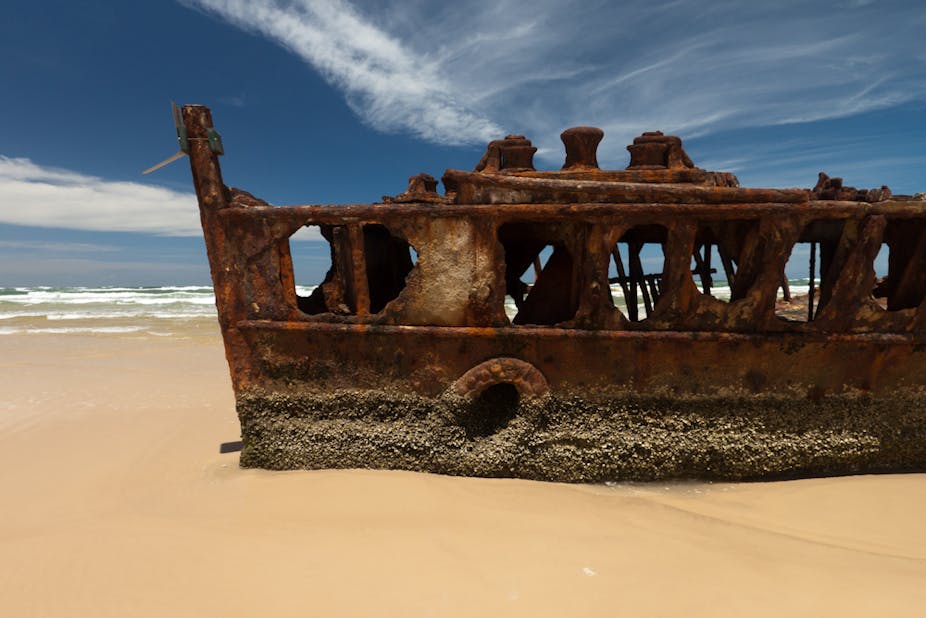New research has shown that the Southern Ocean near Antarctica is filled with whale bone-eating worms, but it lacks wood-eating marine fauna, which are found everywhere else in the world’s oceans. This has major implications for shipwreck hunters.
More formally known as maritime archaeologists they rank alongside astronauts and photo journalists as a “dream job”, because of the image of such individuals diving down to well-preserved shipwrecks standing proud on the seabed in exotic locations. The reality is more mundane.
With a few notable exceptions, most shipwreck sites are important but fundamentally unromantic scatters of debris across and below the ocean floor, marked only by the remains of cargo and ballast, and with little or no upstanding wooden superstructure. In such conditions, only a rare few vessels survive where chance has swiftly buried them in seabed sediments away from the voracious appetites of such animals: the 16th century Mary Rose in England and the 17th century Vasa in Sweden are the two best-known examples of this phenomenon.

The absence of marine fauna such as the wood-eating worm Xylophagainid bivalves in the Southern Ocean means that here, the popular image of a virtually intact shipwreck standing proud on the ocean floor may for once be a reality. The Southern Ocean thus joins a few other precious locations around the world – such as the Baltic and Black Seas – that are literal shipwreck museums. They have the “perfect” mix of environmental conditions that inhibits the existence of these marine borers that eat up a shipwreck’s wooden hull within years.
With marine borers in the Southern Ocean gone, there is a chance that Endurance, Sir Ernest Shackleton’s vessel on his ill-fated expedition that started in 1914, may be preserved in Antarctic waters. Endurance was lost in October 1915 after getting trapped in the ice, leading to Sir Ernest’s gruelling journey with his crew over ice and by boat to Elephant Island and eventually to South Georgia, culminating in the dramatic rescue of his entire party. The wreck of the Endurance would, if found, join Scott’s hut on Ross Island in Antarctica as a key artefact of a harsh but undeniably romantic period of polar exploration.
The survival of submerged wood in Antarctica also opens up the possibility of other, potentially even more intriguing, shipwrecks being discovered in the region. The Southern Ocean was a well-known haunt of countless whaling ships in the 19th and early 20th centuries. Their presence in this region most emotively represented by the ghostly remains of the whaling station of Grytviken on the island of South Georgia that was occupied between 1904 and 1966 (that happens to also be the location of Sir Ernest’s grave). There may be many well-preserved whaling ships waiting to be discovered in Antarctica, offering an insight into the lives of these toughest of professional seamen.

An even more intriguing possibility is that the remains of the San Telmo, a Spanish 74-gun ship-of-the-line lost in 1819 in the Drake Passage south of Cape Horn, might be discovered. Parts of the wreck of the San Telmo were found on Livingston Island in Antarctica by later whalers, and the crew of the vessel are unofficially recorded as the first humans to die in Antarctica.
Such a discovery would have major implications for maritime archaeology – especially if the ship survived in good condition – but would also raise geopolitical tensions over the control of Antarctica and especially its outlying islands such as South Georgia, the South Sandwich Islands and the Falklands Islands, all currently British Overseas Territories but claimed by Argentina. The presence of such an early Spanish vessel in the region would inevitably call into question once again British claims of sovereignty, claims which are at least in part associated to the endeavours of early British explorers here.
A note of caution
The lack of marine borers does not guarantee the pristine survival of the Endurance or indeed any other wooden vessel in Antarctica. In the case of the Endurance, the ship was partially crushed by the ice and also stripped of its most essential equipment prior to abandonment. Moreover, studies of comparable shipwreck sites in the Arctic, most notably vessels associated with the search for the ill-fated Franklin expedition of 1845 to discover the North-West Passage, have demonstrated the amount of post-wrecking damage that can be done to wooden shipwrecks thanks to the movement of ice flows and strong currents over the remains of wrecks, further crushing and scattering hulls and cargoes alike. There is also the problem of finding shipwrecks in the unimaginably vast, lonely and inhospitable Southern Ocean, where survey work can only be undertaken at great expense and with tremendous caution for a few months of each year.
The rediscovery of the Endurance may thus take many more years, but the hopes have never been higher than they are now.

